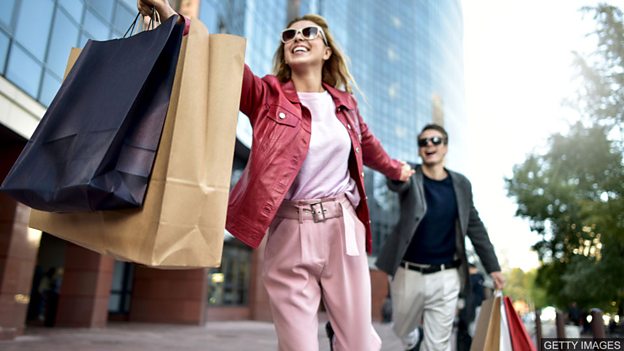随身英语
The problem with fast fashion 快时尚带来的问题

有很多人都喜欢买衣服。在英国,近年来人们购买衣服的数量比以往任何时候都要多。买得多,扔得也多。这种快速服装消费模式被称为 “快时尚”,它给社会和环境带来了不少问题。面临 “快时尚”,我们能做些什么?“随身英语” 讨论快时尚所带来的问题。
Vocabulary: fashion 词汇:时尚
There's nothing quite like new clothes, is there? The UK certainly loves them. According to a report by the Environmental Audit Committee (EAC), the UK consumes five times more clothes today than it did in the 1980s. That's more than any other nation in Europe and amounts to around 26.7kgs per person. This results in 235 million garments going to landfill – victims of fast fashion.
Fast fashion is defined as “an accelerated fashion business model” involving “increased numbers of new fashion collections every year”, “quick turnarounds” and “lower prices”, according to the EAC. Globalisation means that attire is made in countries where labour is cheaper. This saving is passed on to consumers, who then consider the garb they own disposable – easily replaceable with something more on-trend. And that creates problems.
First, there's the environmental cost. Manufacturing any kind of textile costs resources. For example, synthetic fibres, which are made from plastic, have a larger carbon footprint than natural ones. Natural fibres, although more carbon-efficient, still require more water to grow. And further resources are used as the cloth is dyed, made into clothing and transported to retail for sale. Secondly, the fast-fashion industry is under pressure to put the latest trending items on shelves fast, which can lead to workers being exploited and forced to labour in poor working conditions. In countries such as Bangladesh, Ethiopia and the Philippines, workers are paid wages that are insufficient to live on. One worker in Ethiopia told the BBC that they had to deal with intolerable conditions, such as withheld overtime payments, verbal abuse, and unsanitary toilets.
So what can be done in the UK to reduce clothes waste? The EAC has recommended eighteen improvements to the UK government, from increasing tax on purchases to fund recycling centres to introducing more sewing lessons in schools, encouraging a make do and mend attitude when things become threadbare.
What can we do? Shop “second-hand and vintage,” recommends Tolly Gregory, an ethical fashion blogger. Kristabel Plummer, a London-based fashion blogger, who spoke to the BBC, also recommends “looking for quality” and “longevity”. So keep an eye out for durable, resilient, hardy apparel that resists wear and tear.
词汇表
garment 衣服,服装
collection 一系列(新)服装
attire (特定样式或正式的)服装
garb (某种特定样式的)服装
disposable 用完即可丢弃的
on-trend 流行的,时尚的
textile 纺织物
fibre(植物或人造)纤维
dye 染色
retail 零售
sewing 缝纫
make do and mend 不买新的而是修补旧的将就过去
threadbare (衣物)穿旧的,磨破的
second-hand 二手的,旧的
vintage 复古的
durable 耐用的
resilient 有弹性的
hardy 结实耐用的
apparel 衣服,服装
wear and tear 磨损
测验与练习
1. 阅读课文并回答问题。
1. True or False? British people buy the same amount of clothing today as they always have.
2. How do the EAC define 'fast fashion'?
3. What are the problems associated with using either synthetic or natural fabrics?
4. What does the EAC recommend doing to improve the fast fashion situation?
5. What does Kristabel Plummer recommend doing?
2. 请在不参考课文的情况下完成下列练习。选择一个意思恰当的单词填入句子中的空格处。
1. I'm sorry, sir. We can't let you in with that _______. It's formal dress only, I'm afraid.
attire fabric vintage sewing
2. These hiking boots are so _______. I bought them five years ago and they're still in great condition.
vintage threadbare sustainable durable
3. Despite the signs of _______ from use over the years, the dress was in excellent condition.
on-trend make do and mend dyeing wear and tear
4. The house is in terrible condition. The carpets and curtains are _______. It wasn't looked after at all.
sustainable threadbare textile second-hand
5. We need to stop using _______ items. They are extremely wasteful, environmentally speaking.
on-trend disposable sustainable resilient
答案
1. 阅读课文并回答问题。
1. True or False? British people buy the same amount of clothing today as they always have.
False. The UK buys five times more clothes today than it did in the 1980s.
2. How do the EAC define 'fast fashion'?
Fast fashion is defined as “an accelerated fashion business model” involving “increased numbers of new fashion collections every year”, “quick turnarounds” and “lower prices”.
3. What are the problems associated with using either synthetic or natural fabrics?
Synthetic fibres have a larger carbon footprint than natural ones, but natural fabrics require more water.
4. What does the EAC recommend doing to improve the fast fashion situation?
Among their eighteen improvements, they recommend increasing tax on purchases to fund recycling centres and introducing more sewing lessons in schools to encourage a make do and mend mentality.
5. What does Kristabel Plummer recommend doing?
She recommends looking for quality and longevity in clothes.
2. 请在不参考课文的情况下完成下列练习。选择一个意思恰当的单词填入句子中的空格处。
1. I'm sorry, sir. We can't let you in with that attire. It's formal dress only, I'm afraid.
2. These hiking boots are so durable. I bought them five years ago and they're still in great condition.
3. Despite the signs of wear and tear from use over the years, the dress was in excellent condition.
4. The house is in terrible condition. The carpets and curtains are threadbare. It wasn't looked after at all.
5. We need to stop using disposable items. They are extremely wasteful, environmentally speaking.



